
by Scott Muniz | Sep 10, 2020 | Uncategorized
This article is contributed. See the original author and article here.
With less than two weeks until Microsoft Ignite 2020, our Microsoft Search speakers are firing on all cylinders to finalize their sessions for this year’s conference. And while the Ignite session catalog is live at https://myignite.microsoft.com, choosing from hundreds of sessions can take some time even for the veteran attendee. But have no fear, we are here to help! If you’re passionate about Microsoft Search here are the recommended sessions to get you started.

Roadmap, News, and Announcements
Enabling collaboration, communication, and knowledge sharing with Microsoft Teams, SharePoint, Project Cortex, and more
Organizations are moving to a hybrid workplace to support the needs of remote and onsite employees. In the 2nd part of a 2-part series, we look at how teams can collaborate fluidly with the latest innovations across Microsoft Teams, SharePoint, and OneDrive. We also look at how organizations can improve employee engagement, communications, and knowledge sharing through SharePoint, Yammer, and Project Cortex. – Jeff Teper
What’s new and what’s next for Microsoft Search
Get the latest updates on Microsoft Search. Come on the journey to learn how insights, actions, and answers are being built into your everyday experiences across Microsoft 365, Bing, and Edge. See the latest roadmap across all your experiences, from SharePoint to Office and beyond. In addition, get insights into how to connect external third-party content connectors, customization, and extensibility. – Kathrine Hammervold & Robin Thomas
Administration and Management
Learn how Microsoft CSEO use Microsoft search in its enterprise, to boost its workforce’s productivity and finding experience
Learn from Microsoft’s own internal team – CSEO, its sixth engineering and user experience division about how it empowers its users.
Tune in to hear from CSEO about how it serves as the first and best customer, a co-developer and enable its users to find things faster and be more productive using Microsoft search. Learn from CSEO about how the organization is measuring user experiences, empowering its employees using the latest and greatest features of Microsoft search and partnering with its sister organization to improve the product further. – Anishkumar Thoppil Ramakrishnan, Vijaya Alaparthi, Dodd Willingham & Sapna Nadkarni
Make the most of Microsoft Search through Configuration and Administration
Deliver value, knowledge, and answers with precision to improve discovery and productivity. In this session we will cover the role of the search administrator and how they can use Microsoft Search to improve user productivity. We will also look into the future and explore how the role intersects with knowledge management and other user productivity experiences. – Mugdha Pophali & Lesha Bhansali
Unifying your organization’s search experience with minimal effort
Microsoft Search and Graph connectors together empower you to eliminate data silos to provide a unified experience for your users to search for information they need. In this session, you will learn about powerful differentiating features and capabilities that our partners can provide to help you achieve the ultimate search experience for your organization. – James Lau & Microsoft Partners
What’s new with Microsoft Search in Microsoft 365 applications and services
Microsoft Search in SharePoint and OneDrive for Business
Microsoft Search is built directly into the experiences in SharePoint and OneDrive for Business. This session will cover the features available from enterprise search scenarios in SharePoint Start Page/Home Sites, to search capabilities in sites and across hubs, as well as in lists and libraries. We will also look at some of the newer search capabilities in OneDrive for Business, including being able to search in shared libraries. – Thanuja Priyadarshani & Kerem Yuceturk
What’s new and what’s next for Microsoft Search in Microsoft Teams
The goal for search in Microsoft Teams is to help you achieve more by making information in Microsoft 365 easy to navigate, find, research, and assist in task completion. Come learn about the features which we have released in Teams search including contextual search, intelligent people lookups, message search and more, backed by the incredibly powerful and intelligent Microsoft Search platform. We will also do a sneak peek of the full-page immersive search result page experience which we are building to help you be more productive. – Raja Mohan & Sruthy P Narayanan
Completing the Search journey – Search your documents like you search the web
Finding the right answers in a long document is very time-consuming and error prone. We regularly hear from customers: why can’t this just work like when I search on the web? In this session, we’ll look at how we’re bringing the power of the latest web Search experiences can power in document search and answer finding. – Derik Stenerson
What’s new and what’s next for Microsoft Search in Bing
Make searching for your enterprise as easy and convenient as searching the web. See how you can save people time and your company money when info from across the cloud, intranet, SharePoint, and Office are just a few keystrokes away. We’ll demo new features and give you a sneak peek of what’s coming next, as well as share change management strategies so you’re sure to make a big impact this year with Microsoft Search. – Livani Pillay
What’s new for Microsoft Search in Outlook
Get the latest on what’s new and what’s coming to Microsoft Search in Outlook. – Tali Roth
Search in the Productivity Applications
This session will focus on the new experiences we are delivering via search in the Office productivity applications such as Word, Excel, and PowerPoint. We will cover how search connects users to the knowledge of the organization and the world while helping users to stay in the flow of their work. – Nathan Freier
Customizing Microsoft Search
Moving classic SharePoint search to Microsoft Search
Microsoft Search is the best foot forward for companies in Enterprise Search scenarios with built-in people search, personalized suggestions and ranking, admin capabilities with analytics, bookmarks, locations, floor plans, as well as customization features such as ingesting content that’s outside of Microsoft 365. It is built into Teams, Outlook, SharePoint, OneDrive, office.com and Bing so that users are already set up to use it in the applications they use every day. It is designed to work on day one without the need for customer tuning or set up but can be made better if there is an administrator that’s willing to configure and customize.
Microsoft Search is already available and being used by your users. To ensure consistency and familiarity for your users it is time to finally invest in Microsoft Search.
If you have questions about why you should transition, or how you can best plan the transition, we will walk you through it. – Jyoti Pal & Mikael Svenson
Make Microsoft Search uniquely yours with new customization options
Modern information workers need to find knowledge quickly and easily through familiar and intuitive experiences wherever they’re already working. In this session, we’ll demonstrate how Microsoft Search will let you create and customize rich search experiences around all of your enterprise content, regardless of where it resides. See examples of how to modernize your existing enterprise search experiences to take full advantage of Microsoft Search from Bing, to Office to SharePoint and beyond. – Roshan Dheram & Ram Poornalingam
Use Microsoft Search API in our own application
Modern information workers need to find knowledge quickly and easily through familiar and intuitive experiences wherever they’re already working. In this session, we’ll demonstrate how Microsoft Search API in the Microsoft Graph will let you create rich search experiences around all of your enterprise content, regardless of where it resides. See some examples of how-to bring search closer to users and how to programmatically take full advantage of Microsoft Search. – Nicolas Moreau
Microsoft Graph connectors
Graph connectors for Microsoft Search: What’s new?
Graph connectors for Microsoft Search allows organizations to bring content from 3rd party data sources into the search index. This enables the end-users in the organization to be able to search the M365 content and 3rd party content all in a single place i.e. SharePoint, Office.com or Bing.com etc. We have 10 Microsoft built connectors and 130+ partner-built connectors. In this session, we will demonstrate some of the newer Microsoft built connectors and some new capabilities built in connectors and the end user experience for searching the 3rd party content. – Shakun Grover, Vamsi Bhagi & Suhel Parekh
Implementing open enterprise search with Microsoft Search & Microsoft Graph connectors
Modern information workers need to find knowledge quickly and easily regardless of where the data resides in your organization. In this session, you will learn about how you can use Microsoft Graph connectors to connect your worlds of information to Microsoft Search and Microsoft 365, empowering your users with the relevant information at their fingertips. – James Lau & Mounika Narayanan
Breakthrough Innovation
Introducing people search in Microsoft Search
Microsoft Search has always put people first and at the center of search… usually when you’re searching for information, you work from its edges to its center, in the same way we may build a puzzle. The strength of Microsoft Search is that is allows you to build that information from the center, the person, outward.
It’s people who create and curate knowledge, and we believe that allowing you to anchor on that person, their knowledge, and solve the information puzzle working outward, delivers greater precision, and a more delightful experience – because sometimes the answer you’re looking for isn’t found in a document, it’s found in a person. – Ashley Hall
Applying AI at Scale with Microsoft Search
Businesses worldwide are learning AI is incredibly useful to deriving insights from massive data sets and therefore helping reduce repetitive tasks; however, with that there is also the realization that is only half of the equation. The other half is that of maximizing employee’s ability to take these AI-driven insights and use them in creative ways to solve challenges, identify opportunities, and democratize knowledge.
With Microsoft 365, the world’s productivity cloud, we’re bringing world class productivity experiences across apps services. Thanks to new technologies like artificial intelligence (AI) and automation, we can build experiences across devices to connect organizations from the shop floor to the top floor. Through our deep learning models, we’re able to bring new, innovative experiences across the products you’re already using.
In this session learn more about how we’re applying AI at Scale to deliver world class experiences that allow you to find more, do more, and discover more with Microsoft Search. – Youngji Kim & Kate Cook
—
And this is just the beginning, be sure to check out sessions from Microsoft Teams, Outlook, Project Cortex, Cortana, and more for additional coverage of Microsoft Search at Ignite.
In addition, we’ll be offering unique opportunities to engage with our product teams, get answers to your questions, and more. Stay tuned for details.
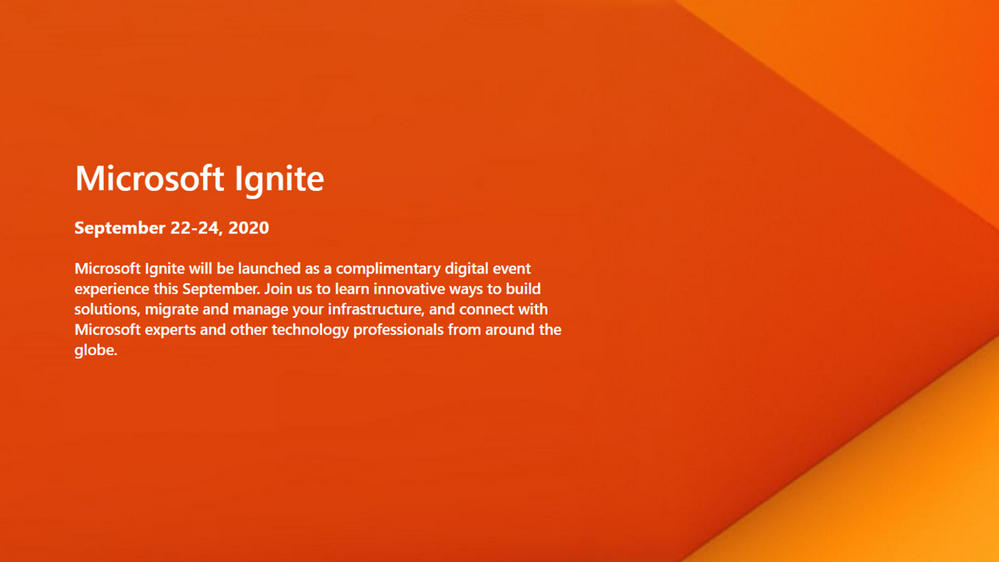
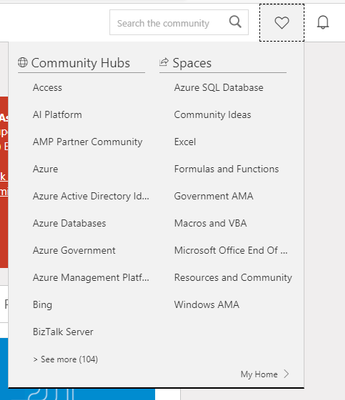
by Scott Muniz | Sep 10, 2020 | Uncategorized
This article is contributed. See the original author and article here.
Over the last couple of months, we have been making some changes to the Microsoft Tech Community to improve page load times and user experience. We are pleased to share with you the next update.
In this update we have made changes to:
- My Dashboard
- Community Hubs
- Community Banners
- Primary Search
- Microsoft Verified Answer
My Dashboard
The old “My Home”, though much loved by community super users, MVPs and Employees was originally designed when the community was less than a 10th of size it is today and was not fit for purpose for our community.
With this in mind, we have completely re-skinned both the shortcut and the My Dashboard view and added some new features we hope you will like.
My Shortcuts
My Shortcuts used to be access using the heart symbol in the top right, next to the notification bell.

The new My Shortcuts is accessed using a list icon that is in the same location as the old heart icon:
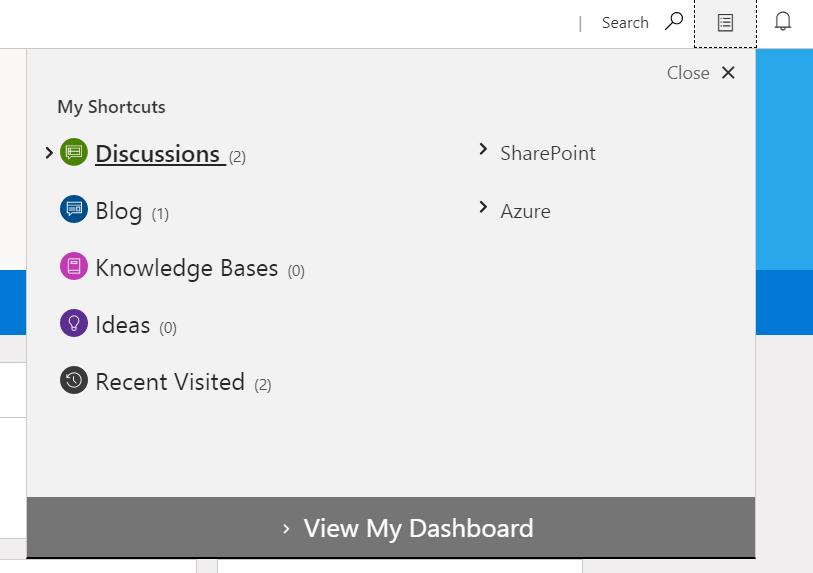
We have tried to focus on getting you to the content we know you are most interested in as quickly as possible, and so My Shortcuts is powered by Discussion Spaces, Blogs, Knowledge Bases, Ideas that you have followed.
Recently Visited stores the last 5 placed you have visited in the Microsoft Tech Community so you can get back to where you left off from, even if it’s not a Space you have previously followed.
My Dashboard
The old My Dashboard was looking a little tired and so within the new My Dashboard you can:
- Manage the communities you have joined.
- Follow and un-follow spaces.
- See your most recent posts, replies, best responses and blog articles.
- Review the 3 newest, most popular, and unanswered questions from the spaces you follow.
- See the 3 latest blog articles from blogs you have followed.
- If there is a question within one of the boards, you follow that has not been answered then there is a component that will ask if you can help answer this. (*)
* Currently this is asking if you can help answer unanswered questions in popular boards but we will be changing this behaviour shortly to use the boards you have followed
In this update we have tried to put you and the content you care the most about front and center and so a new feature we have added to My Dashboard, is the ability to set it as your homepage. When enabled it means the community homepage will always by your dashboard.

Community Hubs
Continuing with the theme in this update of getting you to the content you are looking for as quickly as possible, we redesigned the community hubs page. You will now see all the hubs you have joined by default and have the option to view all hubs on the second tab.
We made the search in Community Hubs more powerful, so that when you search by a keyword it not only shows you Hubs that match your keyword but also any spaces. You can Join or leave any hub right from the Community Hubs page, as well as follow or un-follow any spaces.
You can also expand a Community Hub card and see the most recently active spaces for that hub.
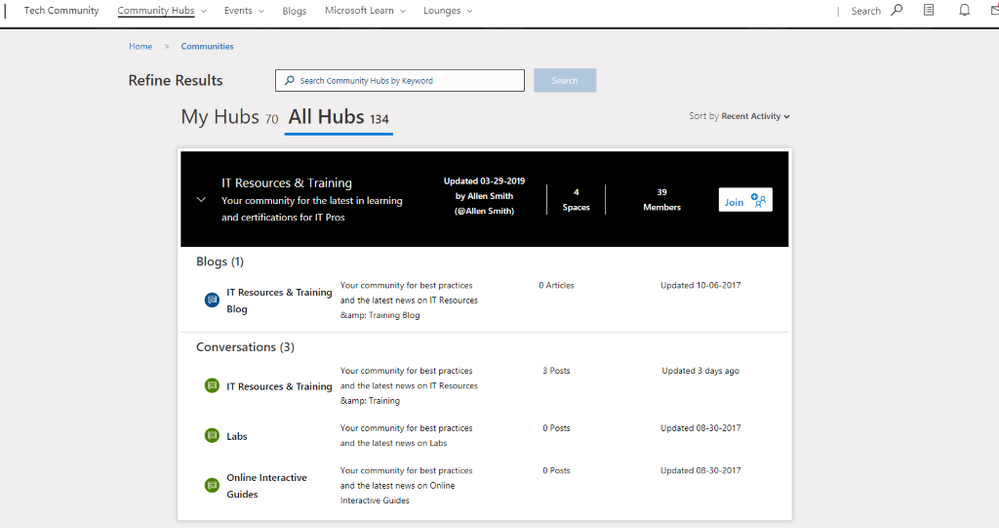
By default, the hubs are sorted by most recent activity but can also be sorted by:
- A to Z
- Z to A
- Newly Added
Community Banners
We took the opportunity to redesign the Microsoft Tech Community banners so that we could make better use of this hero space to not only communicate where you are in the Microsoft Tech Community, but also the activity in the community hub you are currently viewing. A key part of this design change was to also make the header more accessible and work across screen sizes. For communities that do not have a custom banner this is what the new community banner looks like.

For communities that have custom banners we have tried to balance this customization with the need to make the site feel consistent.

Primary Search
In an effort to give search a little more prominence, when a user clicks our search button it now overlays over our primary navigation to give a much larger space for quick results to display. This also helps provide a more consistent search experience across all screen sizes.
We are currently working on an update which will also make the size of the quick results drop down take advantage of this extra space.
Microsoft Verified Answer
Working in a similar way to the Best Solutions system we already provide today, but managed by Microsoft Employees, the purpose of this is to give us a way to highlight answers that are provided in the community that align with Microsoft’s policies, guidelines or best practices.
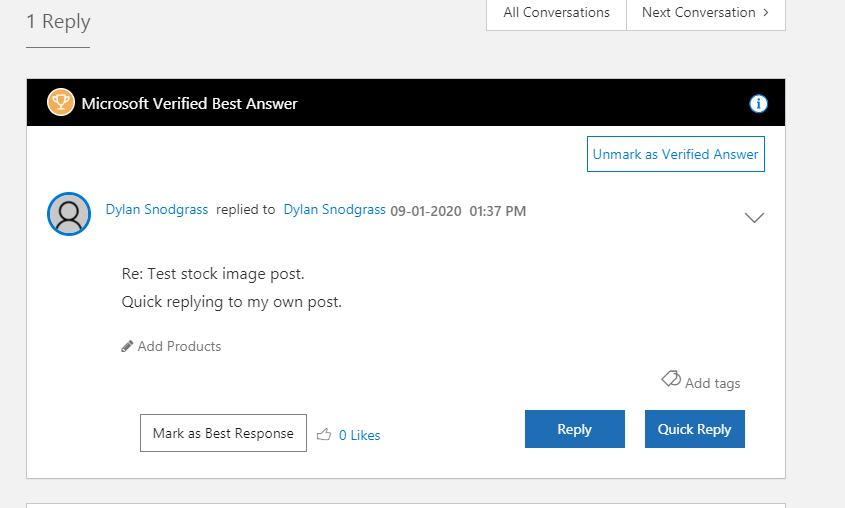
Have questions or feedback? Feel free to post them in the comments below.
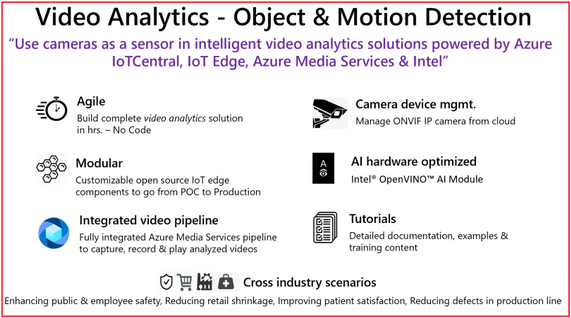
by Scott Muniz | Sep 10, 2020 | Azure, Technology, Uncategorized
This article is contributed. See the original author and article here.
We just made building video analytics solutions simpler from edge to cloud with a new Azure IoT Central application template. This application template integrates Azure Live Video analytics video inferencing pipeline and OpenVINO™ AI Inference server by Intel® to build an end to end solution in a few hrs.
The number of IP cameras is projected to reach 1 billion (globally) by 2021. Traditionally, these types of cameras are used for security and surveillance. With the advent of video AI, businesses increasingly want to use their cameras to extract insights that help improve their profitability and automate (or semi-automate) their business processes. Such video analytics applied to live video streams help businesses react to real-time events and derive new business insights by observing trends over time.
Building a video analytics solution involves multiple complicated phases. This is relatively elaborate instrumentation that requires significant technical expertise and time. These solutions typically start with setting up new cameras or leveraging existing IP cameras for video traffic. IP cameras are versatile devices that support comprehensive configuration and management based on ONVIF standards. Once the IP cameras are set up, you need to ingest the video feeds, process the video, and prepare frames for analysis using inference servers that use specific AI models. These inference servers must be highly performant so that the solution can scale to dozens of cameras at any facility. The results from video analytics need to be collected and stored along with the relevant video for business applications to consume.
Using the new Azure IoT Central application template you can design, define, deploy, scale, and manage a live video analytics solution within hours. Video analytics template supports object and motion detection scenarios with key value propositions, as shown in the following illustration.

Figure 1. Customer & Partner value proposition from Video Analytics – Object and Motion detection app template
In our mission to democratize video analytics, Microsoft and Intel collaborated to build end-to-end video analytics solutions using IoT Central. These solutions leverage:
- Live Video Analytics on IoT Edge (LVA) to capture, record, and analyze live video. LVA is a platform for building AI-based video solutions and applications that include AI applications to live video. You can generate real-time business insights from live video streams, process data near the source to minimize latency and bandwidth requirements and apply the AI models of your choice. LVA provides a flexible programming model to design live video workflows and defines an extensibility model for integrating with inference servers. This frees you up to focus development efforts on the business outcome rather than setting up and operating a complex, live video pipeline.
- For real-time analysis of live video feeds, the video pipeline leverages OpenVINO™ Model Server (OVMS), an inference server that’s highly optimized for AI vision workloads and developed for Intel® architectures. OVMS is powered by OpenVINO™ toolkit, a high-performance inference engine optimized for Intel® hardware on the Edge. An extension has been added to OVMS for easy exchange of video frames and inference results between the inference server and LVA, thus empowering you to run any OpenVINO™ toolkit supported model, and select from the wide variety of acceleration mechanisms provided by Intel® hardware. These include CPUs (Atom, Core, Xeon), FPGAs, VPUs.
- Azure IoT Central is a platform for rapidly building enterprise-grade IoT applications on a secure, reliable, and scalable infrastructure. IoT Central simplifies the initial setup of your IoT solution and reduces the management burden, operational costs, and overhead of a typical IoT project. This enables you to apply your resources and unique domain expertise to solving customer needs and creating business value, rather than needing to tackle the mechanics of operating, managing, securing, and scaling a global IoT solution.
The IoT Central application template brings the goodness of Azure IoT Central, Live Video Analytics, and Intel components integration to enable building scalable solutions in a few hrs. as described in tutorials

Figure 2. Block diagram of Video Analytics – Object and Motion Detection app template
The app template stitches the following components,
- Cloud Services – IoT Central Video Analytics Application Template to stich the end-end solution & Azure Media Services for video snippet storage
- Edge Modules – Video processing pipeline (Live Video Analytics), hardware optimized OpenVINO™ AI Inference server by Intel, IoT Central gateway module to for protocol & identify translation of RTSP & Camera, RTSP Server (Live 555) for pre-recorded video strams
- Connecting & managing IP Camera, RTSP streams and AI module configuration
The IoT Central application template natively provides device operators view for object and motion detection scenarios, as shown in the following illustration.

Figure 3. Dashboard from IoT Central template for Video Analytics – Object & Motion Detection
The dashboard in the new Video Analytics – Object & Motion Detection template for IoT Central is shown above. The template requires,
- IP cameras (any IP cameras that support RTSP on the ONVIF conformant products page devices that conform with profiles G, S, or T), or You can leverage simulated video stream that we ship as part of this template for demonstrations.
- Linux server powered by your choice of Intel® acceleration technology (CPUs such as Atom, Core, Xeon, or FPGAs, or VPUs)
- Azure subscription to host relevant cloud services.
Get started today
- You can use the new Video Analytics for Object & Motion Detection template to build and deploy your live video analytics solution.
- You can build Video Analytics solution within hours by leveraging Azure IoT Central, Live Video Analytics, and Intel.
- You can learn more about Live Video Analytics on IoT Edge here, and try out some of the other video analytics scenarios via the quickstarts and tutorials here. These show you how you can leverage open source AI models such as those in the Open Model Zoo repository or YOLOv3, or custom models that you have built, to analyze live video.
- You can learn more about the OpenVINO™ Inference server by Intel® in Azure marketplace and its underlying technologies here. You can access developer kits to learn how to accelerate edge workloads using Intel®-based accelerators CPUs, iGPUs, VPUs and FPGAs. You can select from a wide range of AI Models from Open Model Zoo






Recent Comments